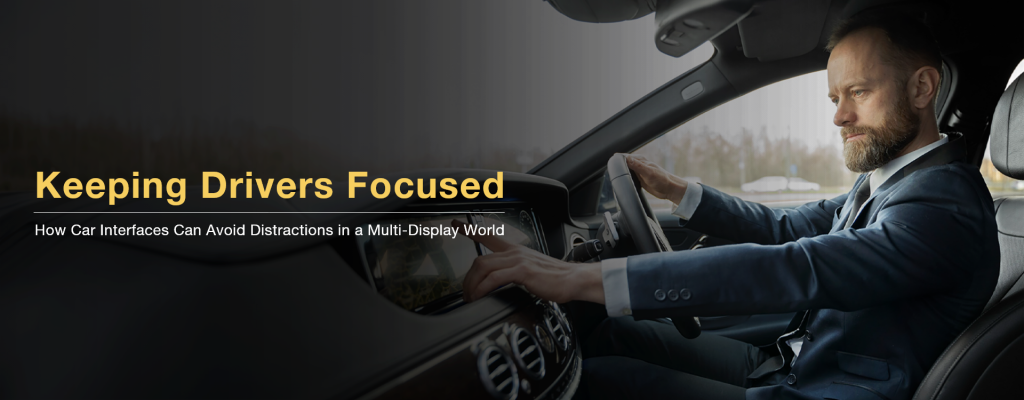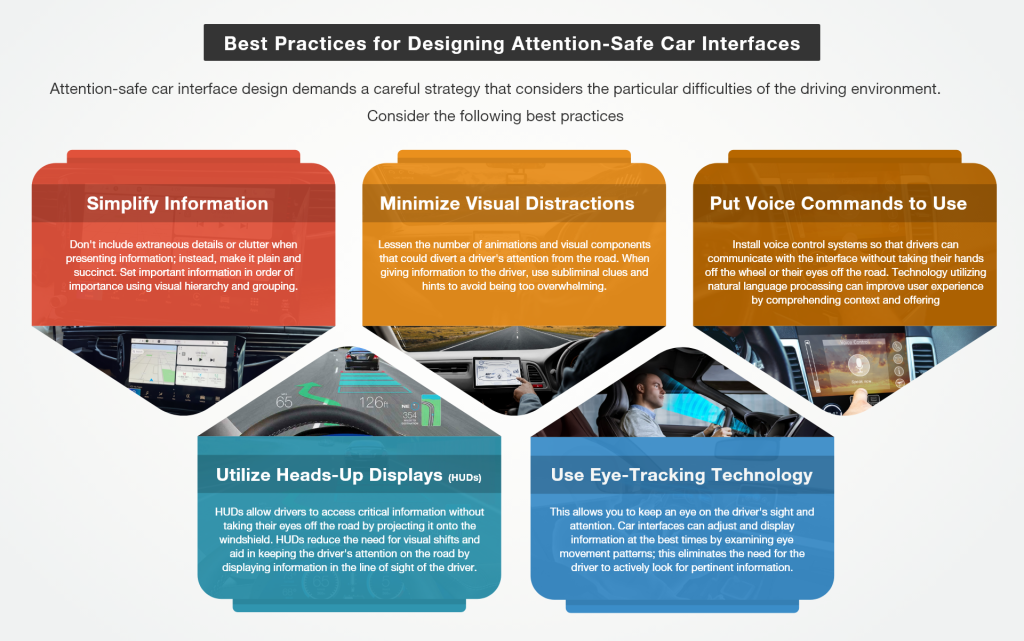
Posted On May 05 2024 | 10:55
It’s more important than ever to design automotive interfaces that protect drivers’ attention and keep them focused in the multi-display world we live in. Harmonious driving experiences are now essential, and designing interfaces for cars that blend innovation and simplicity is crucial.
As auto technology advances, cars increasingly have several displays for infotainment systems, navigation apps, and instrument clusters, among other uses. Although these screens are convenient and improve the driving experience, they also present serious attention management difficulties.
A major obstacle is the possibility of information overload. There is a chance that a driver may experience cognitive overload because of having too much information displayed on several screens competing for their attention. This may cause drivers to pay less attention to the road and raise the risk of accidents.
The possibility of visual disturbance presents another difficulty. Every display could cause a driver to take their eyes off the road, forcing them to adjust their focus and focus elsewhere. This can be particularly risky in circumstances where prompt decisions or actions are necessary.
The well-known effects of distracted driving include numerous collisions and fatalities brought on by drivers losing their focus on the road. It is crucial to consider attention safety while designing automotive interfaces since it can literally mean the difference between life and death.
We can build interfaces for cars that limit distractions and encourage a more engaged and focused driving experience by giving attention safety first priority. This is finding a balance between giving the driver the information they need and avoiding adding needless visual or cognitive strain.
However, this does not mean that other displays and information are irrelevant. It is important to consider the driver’s cognitive workload and ensure that non-essential information is presented in a way that does not cause undue distraction. This can be achieved through careful information hierarchy and effective visual design.

User interface (UI) design plays a crucial role in attention-safe car interfaces. By following UI design best practices, car interfaces can be optimized for safe and seamless driving experiences.
An important component of attention-safe car interfaces is user interface (UI) design. Automobile interfaces can be enhanced for smooth and safe driving experiences by adhering to UI design best practices. The use of contrast and color in UI design is crucial. Use vivid, eye-catching colors sparingly and only when necessary to communicate crucial information or alerts. However, excessively muted or low contrast colors can hinder drivers’ ability to swiftly and effectively understand information. The size and arrangement of interactive elements is another factor to take into account. Large enough buttons and controls should be accessible without needing to be precisely targeted. Additionally, they must to be arranged so as to reduce the amount of time the driver must look away from the road.
Voice control have become an effective way to communicate with automotive interfaces without sacrificing focus or security. Car interfaces that incorporate natural language processing (NLP) technology may comprehend and react to commands from drivers, giving them the ability to access information, make phone calls, and operate numerous systems without requiring manual input. Recent major developments in NLP technology have made it possible for automobile interfaces to comprehend intricate and context-rich commands. As a result, using the car’s interface will be easier to use and less distracting for drivers since they may give commands in a more casual and conversational way. NLP can be utilized to offer proactive support in addition to standard voice commands. For instance, the vehicle’s interface may proactively offer to look for nearby gas stations and offer navigational guidance if it notices that the driver is running low on fuel. This guarantees that the driver gets the information they need without having to actively seek it out, and lessens the cognitive strain on them.
To further improve attention safety, eye-tracking technologies can also be applied. Car interfaces can tell when a driver is looking away from the road for an extended amount of time by tracking their gaze. In these situations, the interface can minimize distraction by gently reminding users or changing how information is presented.
Designing automotive interfaces that put attention to safety first is crucial in a time when distractions are common. We can design interfaces that improve driving without sacrificing safety by taking user behavior into account, putting best practices into practice, and utilizing technology.
There are many techniques and tools available to support attention safety in car interfaces, ranging from streamlining information and reducing distractions to using voice commands, heads-up displays, and eye-tracking technology. We can anticipate more developments in automotive interface design in the future, which will completely change how drivers interact with their cars.
The goal at People Tech Group to provide harmonious driving environments that maintain drivers’ attention, involvement, and safety while driving. We can guarantee that attention to safety stays at the forefront of automotive design, making every ride a peaceful and secure one, by creating interfaces for cars that achieve the ideal balance between innovation and simplicity.
